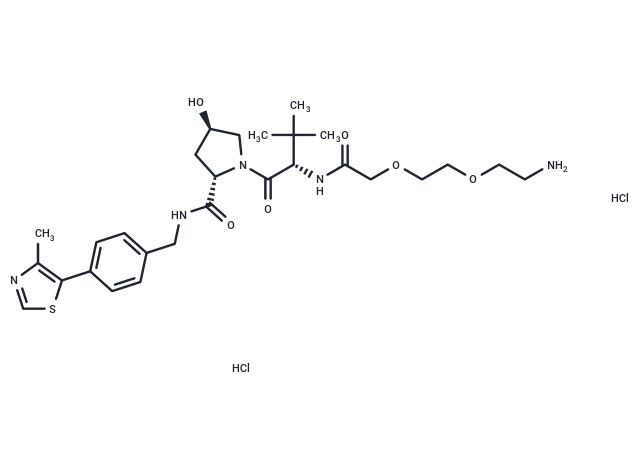Shopping Cart
- Remove All
 Your shopping cart is currently empty
Your shopping cart is currently empty

(S,R,S)-AHPC-PEG2-NH2 dihydrochloride (VH032-linker 12) is a synthesized E3 ligase ligand-linker conjugate that incorporates the (S,R,S)-AHPC-based VHL ligand and a 2-unit PEG linker[1].

| Pack Size | Price | Availability | Quantity |
|---|---|---|---|
| 5 mg | $34 | In Stock | |
| 10 mg | $55 | In Stock | |
| 25 mg | $113 | In Stock | |
| 50 mg | $178 | In Stock | |
| 100 mg | $255 | In Stock |
| Description | (S,R,S)-AHPC-PEG2-NH2 dihydrochloride (VH032-linker 12) is a synthesized E3 ligase ligand-linker conjugate that incorporates the (S,R,S)-AHPC-based VHL ligand and a 2-unit PEG linker[1]. |
| In vitro | PROTACs exploit the intracellular ubiquitin-proteasome system to selectively degrade target proteins[1]. |
| Alias | VH032-PEG2-NH2 dihydrochloride, VH032-linker 12, VH032 amide-PEG2-amine |
| Molecular Weight | 648.64 |
| Formula | C28H43Cl2N5O6S |
| Cas No. | 2341796-76-5 |
| Smiles | CC1=C(SC=N1)C2=CC=C(C=C2)CNC(=O)[C@@H]3C[C@H](CN3C(=O)[C@H](C(C)(C)C)NC(=O)COCCOCCN)O.Cl.Cl |
| Relative Density. | no data available |
| Storage | Powder: -20°C for 3 years | In solvent: -80°C for 1 year | Shipping with blue ice. |

Copyright © 2015-2025 TargetMol Chemicals Inc. All Rights Reserved.